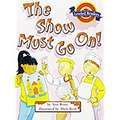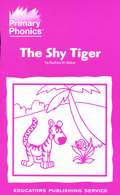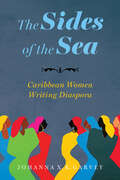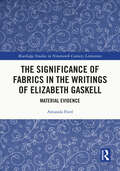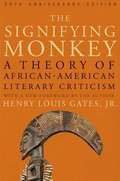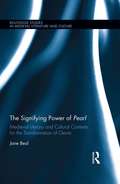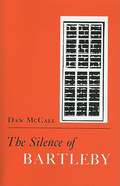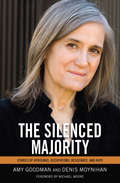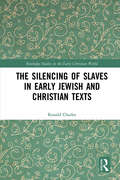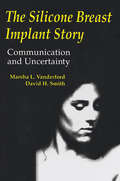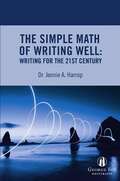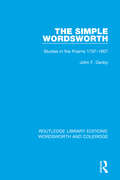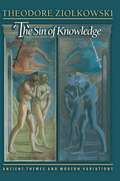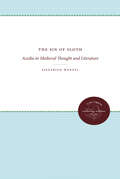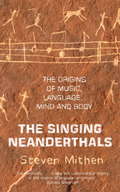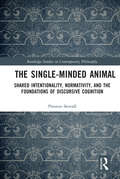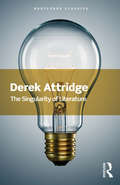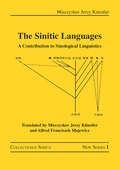- Table View
- List View
The Sides of the Sea: Caribbean Women Writing Diaspora (Caribbean Studies Series)
by Johanna X. GarveyIn The Sides of the Sea: Caribbean Women Writing Diaspora, Johanna X. K. Garvey examines the works of contemporary writers from eight Caribbean countries, including Haiti, Trinidad and Tobago, and the Dominican Republic. Authors from Anglophone, Francophone, and Spanish-speaking countries illustrate experiences across the African Diaspora, including enslavement, colonialism, revolt, marronage, and decolonization. Characters in fiction and poetry by such writers as Erna Brodber, Jan J. Dominique, Mayra Santos-Febres, Tessa McWatt, and Dionne Brand confront trauma, engage in struggle, forge connection, and act as agents of change. Complicating categories of identification and employing multiple strategies of resistance, these Caribbean women writers show us paths out of and beyond the binaries embedded in colonialism and its aftermath. As their texts remember moments and sites of trauma beginning with the Middle Passage, they embark on new passages, claim oceanic spaces, and suggest directions that stretch beyond the Black Atlantic to a more complex understanding of how to “pull the sides of the sea together” in the twenty-first century. The Sides of the Sea is organized in three sections: “Plumbing the Depths,” which examines representations of the Middle Passage and its legacies; “Voicing the Wounds,” which explores genealogies, inherited trauma, and potential healing; “Unsettling Borders,” which discusses decolonial epistemologies, transgressive sexualities, and new visions of citizenship.
The Significance of Fabrics in the Writings of Elizabeth Gaskell: Material Evidence (Routledge Studies in Nineteenth Century Literature)
by Amanda FordElizabeth Gaskell’s writings abound in references to a cultural materiality encompassing different types of fabric, stuffs, calicoes, chintzes and fine-point lace. These are not merely the motifs of the Realist genre but reveal a complex polysemy. Utilizing a metonymic examination of these tropes, this volume exposes the dramatic structural and socio-economic upheaval generated by industrialization, urbanization and the widening sphere of empire. The material evidence testifies to the technological and production innovations evolving diachronically for the period, and the evolution of Manchester as the industrial ‘Cottonpolis’ that clothed the world by the 1840s. This volume analyses Gaskell’s manipulation of the materiality, arguing its firm roots in the quotidian of women’s domestic and provincial life within the growing ranks of the middle classes. Exploring Gaskell’s tactile imagination, an embodied relationship with fabrics and sewing, a function of her daily life from an early age, this volume provides insight into the sensory aspects of cloth and its ability to stir affective responses, emotions and memories, whereby worn fabrics and even the absence of previous textile treasures, is poignant, recreating layers of recollection. This book aims to restore the pulsating, dynamic context of ordinary women’s dressed lives and presents innovative interpretations of Gaskell’s texts.
The Signifying Monkey: A Theory of African American Literary Criticism
by Henry Louis GatesThis book is a groundbreaking work that illuminates the relationship between the African and African-American vernacular traditions and black literature. It elaborates a new critical approach located within this tradition that allows the black voice to speak for itself. Examining the ancient poetry and myths found in African, Latin American, and Caribbean culture, the author uncovers a unique system for interpretation and a powerful vernacular tradition that black slaves brought with them to the New World. Exploring the process of signification in black American life and literature by analyzing the transmission and revision of various signifying figures, He provides an extended analysis of what he calls the "Talking Book," a central trope in early slave narratives that virtually defines the tradition of black American letters. He uses this critical framework to examine several major works of African-American literature and revealing how these works signify on the black tradition and on each other. This superb 25th-Anniversary Edition features a new preface by the author that reflects on the impact of the book and its relevance for today's society as well as a new afterword written by noted critic W. T. J. Mitchell.
The Signifying Power of Pearl: Medieval Literary and Cultural Contexts for the Transformation of Genre
by Jane BealThis book enhances our understanding of the exquisitely beautiful, fourteenth-century, Middle English dream vision poem Pearl. Situating the study in the contexts of medieval literary criticism and contemporary genre theory, Beal argues that the poet intended Pearl to be read at four levels of meaning and in four corresponding genres: literally, an elegy; spiritually, an allegory; morally, a consolation; and anagogically, a revelation. The book addresses cruxes and scholarly debates about the poem’s genre and meaning, including key questions that have been unresolved in Pearl studies for over a century: * What is the nature of the relationship between the Dreamer and the Maiden? * What is the significance of allusions to Ovidian love stories and the use of liturgical time in the poem? * How does avian symbolism, like that of the central symbol of the pearl, develop, transform, and add meaning throughout the dream vision? * What is the nature of God portrayed in the poem, and how does the portrayal of the Maiden’s intimate relationship to God, her spiritual marriage to the Lamb, connect to the poet’s purpose in writing? Noting that the poem is open to many interpretations, Beal also considers folktale genre patterns in Pearl, including those drawn from parable, fable, and fairy-tale. The conclusion considers Pearl in the light of modern psychological theories of grieving and trauma. This book makes a compelling case for re-reading Pearl and recognizing the poem’s signifying power. Given the ongoing possibility of new interpretations, it will appeal to those who specialize in Pearl as well as scholars of Middle English, Medieval Literature, Genre Theory, and Literature and Religion.
The Silence of Bartleby
by Dan MccallIn this work of criticism, Dan McCall proposes a new reading of Herman Melville's classic short tale "Bartleby, The Scrivener."
The Silence of the Miskito Prince: How Cultural Dialogue Was Colonized
by Matt CohenConfronting the rifts created by our common conceptual vocabulary for North American colonial studies How can we tell colonial histories in ways that invite intercultural conversation within humanistic fields that are themselves products of colonial domination? Beginning with a famous episode of failed communication from the narrative of the freed slave Olaudah Equiano, The Silence of the Miskito Prince explores this question by looking critically at five concepts frequently used to imagine solutions to the challenges of cross-cultural communication: understanding, cosmopolitanism, piety, reciprocity, and patience. Focusing on the first two centuries of North American colonization, Matt Cohen traces how these five concepts of cross-cultural relations emerged from, and continue to evolve within, colonial dynamics. Through a series of revealing archival explorations, he argues the need for a new vocabulary for the analysis of past interactions drawn from the intellectual and spiritual domains of the colonized, and for a historiographical practice oriented less toward the illusion of complete understanding and scholarly authority and more toward the beliefs and experiences of descendant communities. The Silence of the Miskito Prince argues for new ways of framing scholarly conversations that use past interactions as a site for thinking about intercultural relations today. By investigating the colonial histories of these terms that were assumed to promote inclusion, Cohen offers both a reflection on how we got here and a model of scholarly humility that holds us to our better or worse pasts.
The Silenced Majority: Stories of Uprisings, Occupations, Resistance, and Hope
by Amy Goodman Denis MoynihanThe New York Times–bestselling collection of essays on the power of ordinary people to effect lasting change—from the host and cofounder of Democracy Now! Amy Goodman and Denis Moynihan began writing a weekly column, &“Breaking the Sound Barrier,&” for King Features Syndicate in 2006. This timely new sequel to Goodman&’s New York Times bestseller of the same name gives voice to the many ordinary people standing up to corporate and government power—and refusing to be silent. The Silenced Majority pulls back the veil of corporate media reporting to dig deep into the politics of &“climate apartheid,&” the implications of the Fukushima nuclear disaster, the movement to halt the execution of Troy Anthony Davis, and the globalization of dissent &“from Tahrir Square to Liberty Plaza.&” Throughout, Goodman and Moynihan show the work of ordinary people to change their media—and change the world. Praise for Amy Goodman &“Amy Goodman has taken investigative journalism to new heights.&” —Noam Chomsky, leading public intellectual and author of Hopes and Prospects &“Amy Goodman is not afraid to speak truth to power. She does it every day.&” —Susan Sarandon, activist and actress &“Crusading journalism at its best.&” —Arianna Huffington, founder of The Huffington Post &“A towering progressive freedom fighter in the media and the world.&” —Cornel West, author of Race Matters &“What journalism should be: beholden to the interests of people, not power and profit.&” —Arundhati Roy, author of The End of Imagination
The Silencing of Slaves in Early Jewish and Christian Texts (Routledge Studies in the Early Christian World)
by Ronald CharlesThe Silencing of Slaves in Early Jewish and Christian Texts analyzes a large corpus of early Christian texts and Pseudepigraphic materials to understand how the authors of these texts used, abused and silenced enslaved characters to articulate their own social, political, and theological visions. The focus is on excavating the texts "from below" or "against the grain" in order to notice the slaves, and in so doing, to problematize and (re)imagine the narratives. Noticing the slaves as literary iterations means paying attention to broader theological, ideological, and rhetorical aims of the texts within which enslaved bodies are constructed. The analysis demonstrates that by silencing slaves and using a rhetoric of violence, the authors of these texts contributed to the construction of myths in which slaves functioned as a useful trope to support the combined power of religion and empire. Thus was created not only the perfect template for the rise and development of a Christian discourse of slavery, but also a rationale for subsequent violence exercised against slave bodies within the Christian Empire. The study demonstrates the value of using the tools and applying the insights of subaltern studies to the study of the Pseudepigrapha and in early Christian texts. This volume will be of interest not only to scholars of early Christianity, but also to those working on the history of slavery and subaltern studies in antiquity.
The Silicone Breast Implant Story: Communication and Uncertainty (Routledge Communication Series)
by David H. Smith Marsha L. VanderfordThis volume examines one health issue -- breast implants -- across a series of contexts often thought to be separate -- media coverage, doctor-patient interaction, doctor-doctor professional communication, support group dialogues, public relations campaigns, and more. In so doing, it provides a narrative of how communication shapes the individual perceptions of health, government, and social policy concerning health care. At the core of the silicone breast implant controversy is the need for people to act amid uncertainty about the health risks involved. This need to weigh action in the midst of uncertain risk characterizes a large number of health issues. The attempts of patients, physicians, drug manufacturers, and others to seek and provide both information and influence makes communication central to these issues. Consequently, the questions explored in this volume will interest a diverse group of readers. This audience includes plastic surgeons in particular, physicians in general, and anyone involved with women's health issues. As the medical profession struggles with its identity amid changes in public attitudes, government regulations, and medical practices, this volume's findings concerning media portrayals of doctors and medical devices become even more important. Finally, this study reveals how interrelated public information and private decisions are, and how closely media and interpersonal relationships fit. Tracing one medical issue across interpersonal, organizational, public relations, and mediated forums has clearly demonstrated the multiple ways those communication channels overlap and inform one another.
The Silver Fork Novel
by Edward CopelandIn the early nineteenth century there was a sudden vogue for novels centering on the glamour of aristocratic social and political life. Such novels, attractive as they were to middle-class readers, were condemned by contemporary critics as dangerously seductive, crassly commercial, designed for the 'masses' and utterly unworthy of regard. Until recently, silver-fork novels have eluded serious consideration and been overshadowed by authors such as Jane Austen. They were influenced by Austen at their very deepest levels, but were paradoxically drummed out of history by the very canon-makers who were using Austen's name to establish their own legitimacy. This first modern full-length study of the silver-fork novel argues that these novels were in fact tools of persuasion, novels deliberately aimed at bringing the British middle classes into an alliance with an aristocratic program of political reform.
The Simple Math of Writing Well: Writing for the 21st Century
by Jennie HarropWriting guides abound, but this book is one of a kind. Readers will find its practical approach affirming, encouraging, and informative, and its focus on the basics of linguistic structure releases 21st-century writers to embrace the variety of mediums that define our internet-connected world. As the author reminds us in the opening chapters of her book, we write more today than ever before in history: texts, emails, letters, blogs, reports, social media posts, proposals, etc. This is the first guide that directly addresses the importance of writing well in the Google age.
The Simple Wordsworth: Studies in the Poems 1979-1807 (RLE: Wordsworth and Coleridge #4)
by John F. DanbyFirst published in 1960, this book studies Wordsworth’s ‘simple’ poems, such as the Lyrical Ballads, as products of a sophisticated and powerfully successful literary genius. The author aims to approach the poems as perhaps Wordsworth expected his first readers to; but as they have never been in fact. The result of this approach is to discover a Wordsworth far different to that which he has previously been presented as — the ‘Sage of Rydal’ at one extreme and a naïve perpetrator of poetical blunders at the other — and, the author argues, a far more exciting one. This book will be of interest to students of literature.
The Sin of Knowledge: Ancient Themes and Modern Variations
by Theodore ZiolkowskiAdam, Prometheus, and Faust--their stories were central to the formation of Western consciousness and continue to be timely cautionary tales in an age driven by information and technology. Here Theodore Ziolkowski explores how each myth represents a response on the part of ancient Hebrew, ancient Greek, and sixteenth-century Christian culture to the problem of knowledge, particularly humankind's powerful, perennial, and sometimes unethical desire for it. This book exposes for the first time the similarities underlying these myths as well as their origins in earlier trickster legends, and considers when and why they emerged in their respective societies. It then examines the variations through which the themes have been adapted by modern writers to express their own awareness of the sin of knowledge. Each myth is shown to capture the anxiety of a society when faced with new knowledge that challenges traditional values. Ziolkowski's examples of recent appropriations of the myths are especially provocative. From Voltaire to the present, the Fall of Adam has provided an image for the emergence from childhood innocence into the consciousness of maturity. Prometheus, as the challenger of authority and the initiator of technological evil, yielded an ambivalent model for the socialist imagination of the German Democratic Republic. And finally, an America unsettled by its responsibility for the atomic bomb, and worrying that in its postwar prosperity it had betrayed its values, recognized in Faust the disturbing image of its soul.
The Sin of Sloth: Acedia in Medieval Thought and Literature
by Siegfried WenzelWenzel presents the history of the concept of acedia, of spiritual sloth," from its origins among the Egyptian desert monks through the Middle Ages to the Renaissance. The investigation proceeds in chronological order and pays close attention to the different emphases and changes the concept underwent.Originally published in 1967.A UNC Press Enduring Edition -- UNC Press Enduring Editions use the latest in digital technology to make available again books from our distinguished backlist that were previously out of print. These editions are published unaltered from the original, and are presented in affordable paperback formats, bringing readers both historical and cultural value.
The Sin of Writing and the Rise of Modern Hebrew Literature (New Directions in Book History)
by Iris ParushThe Sin of Writing and the Rise of Modern Hebrew Literature contends that the processes of enlightenment, modernization, and secularization in nineteenth-century Eastern European Jewish society were marked not by a reading revolution but rather by a writing revolution, that is, by a revolutionary change in this society's attitude toward writing. Combining socio-cultural history and literary studies and drawing on a large corpus of autobiographies, memoirs, and literary works of the period, the book sets out to explain the curious absence of writing skills and Hebrew grammar from the curriculum of the traditional Jewish education system in Eastern Europe. It shows that traditional Jewish society maintained a conspicuously oral literacy culture, colored by fears of writing and suspicions toward publication. It is against this background that the young yeshiva students undergoing enlightenment started to “sin by writing,” turning writing and publication in Hebrew into the cornerstone of their constitution as autonomous, enlightened, male Jewish subjects, and setting the foundations for the rise of modern Hebrew literature.
The Sing-song Girls of Shanghai (Weatherhead Books on Asia)
by Bangqing HanDesire, virtue, courtesans (also known as sing-song girls), and the denizens of Shanghai's pleasure quarters are just some of the elements that constitute Han Bangqing's extraordinary novel of late imperial China. Han's richly textured, panoramic view of late-nineteenth-century Shanghai follows a range of characters from beautiful sing-song girls to lower-class prostitutes and from men in positions of social authority to criminals and ambitious young men recently arrived from the country. Considered one of the greatest works of Chinese fiction, The Sing-song Girls of Shanghai is now available for the first time in English. Neither sentimental nor sensationalistic in its portrayal of courtesans and their male patrons, Han's work inquires into the moral and psychological consequences of desire. Han, himself a frequent habitué of Shanghai brothels, reveals a world populated by lonely souls who seek consolation amid the pleasures and decadence of Shanghai's demimonde. He describes the romantic games played by sing-song girls to lure men, as well as the tragic consequences faced by those who unexpectedly fall in love with their customers. Han also tells the stories of male patrons who find themselves emotionally trapped between desire and their sense of propriety. First published in 1892, and made into a film by Hou Hsiao-hsien in 1998, The Sing-song Girls of Shanghai is recognized as a pioneering work of Chinese fiction in its use of psychological realism and its infusion of modernist sensibilities into the traditional genre of courtesan fiction. The novel's stature has grown with the recent discovery of Eileen Chang's previously unknown translation, which was unearthed among her papers at the University of Southern California. Chang, who lived in Shanghai until 1956 when she moved to California and began to write in English, is one of the most acclaimed Chinese writers of the twentieth century.
The Singing Neanderthals: The Origins of Music, Language, Mind and Body
by Prof Steven MithenA fascinating and incisive examination of our language instinct from award-winning science writer Steven Mithen.Along with the concepts of consciousness and intelligence, our capacity for language sits right at the core of what makes us human. But while the evolutionary origins of language have provoked speculation and impassioned debate, music has been neglected if not ignored. Like language it is a universal feature of human culture, one that is a permanent fixture in our daily lives.In THE SINGING NEANDERTHALS, Steven Mithen redresses the balance, drawing on a huge range of sources, from neurological case studies through child psychology and the communication systems of non-human primates to the latest paleoarchaeological evidence.The result is a fascinating and provocative work and a succinct riposte to those, like Steven Pinker, who have dismissed music as a functionless and unimportant evolutionary byproduct.
The Singing Neanderthals: The Origins of Music, Language, Mind and Body
by Steven MithenA fascinating and incisive examination of our language instinct from award-winning science writer Steven Mithen.Along with the concepts of consciousness and intelligence, our capacity for language sits right at the core of what makes us human. But while the evolutionary origins of language have provoked speculation and impassioned debate, music has been neglected if not ignored. Like language it is a universal feature of human culture, one that is a permanent fixture in our daily lives.In THE SINGING NEANDERTHALS, Steven Mithen redresses the balance, drawing on a huge range of sources, from neurological case studies through child psychology and the communication systems of non-human primates to the latest paleoarchaeological evidence.The result is a fascinating and provocative work and a succinct riposte to those, like Steven Pinker, who have dismissed music as a functionless and unimportant evolutionary byproduct.
The Single Woman, Modernity, and Literary Culture
by Emma SterryThis book situates the single woman within the evolving landscape of modernity, examining how she negotiated rural and urban worlds, explored domestic and bohemian roles, and traversed public and private spheres. In the modern era, the single woman was both celebrated and derided for refusing to conform to societal expectations regarding femininity and sexuality. The different versions of single women presented in cultural narratives of this period--including the old maid, odd woman, New Woman, spinster, and flapper--were all sexually suspicious. The single woman, however, was really an amorphous figure who defied straightforward categorization. Emma Sterry explores depictions of such single women in transatlantic women's fiction of the 1920s to 1940s. Including a diverse selection of renowned and forgotten writers, such as Djuna Barnes, Rosamond Lehmann, Ngaio Marsh, and Eliot Bliss, this book argues that the single woman embodies the tensions between tradition and progress in both middlebrow and modernist literary culture.
The Single-Minded Animal: Shared Intentionality, Normativity, and the Foundations of Discursive Cognition (Routledge Studies in Contemporary Philosophy)
by Preston StovallThis book provides an account of discursive or reason-governed cognition, by synthesizing research in the philosophy of language, the philosophy of mind, and evolutionary anthropology. Using the grasp of a natural language as a model for the autonomous or self-governed rationality of discursive cognition, the author uses a semantics for individual intentions, shared intentions, and normative attitudes as a framework for understanding what it is to be a rational animal. This semantics interprets claims about shared intentions and claims about what people ought and may do as the expression of plans of action that involve taking the points of view of other people within a community. This has important consequences for our understanding of both the natural basis and the social relevance of intentional and normative mental states. In order to distinguish the strong and weak modal force, which characterizes normativity but not shared intentionality, the author argues that a notion of single-minded practical cognition is necessary. This account of single-mindedness is then used to shed light on the autonomy or self-government characteristic of discursive cognition, as manifest in a linguistic community whose members are able to adopt the standpoints of others. Drawing together research in philosophy and the related sciences, the formal account of the semantic content of the claims we use to give expression to shared intentional and normative mental states integrates well with research in cognitive science, evolutionary anthropology, and social psychology concerning the ontogenetic and phylogenetic development of shared intentionality and norm psychology in human beings and other primates. The Single-Minded Animal will appeal to researchers and advanced students working on shared intentionality, normativity, rationality, cognitive science, social and developmental psychology, and evolutionary anthropology.
The Singlish Controversy: Language, Culture and Identity in a Globalizing World
by Lionel WeeSinglish is the colloquial variety of English spoken in Singapore. It has sparked much public debate, but so far the complex question of what Singlish really is and what it means to its speakers has remained obscured. This important work explores some of the socio-political controversies surrounding Singlish, such as the political ideologies inherent in Singlish discourse, the implications of being restricted to Singlish for those speakers without access to standard English, the complex relationship between Singlish and migration, and the question of whether Singlish is an asset or a liability to Singaporeans. These questions surrounding Singlish illustrate many current issues in language, culture and identity in an age of rapid change. The book will be of interest to scholars and advanced students of World Englishes and sociolinguistics. Its detailed analysis of the Singlish controversy will illuminate broader questions about language, identity and globalization.
The Singularity of Literature (Routledge Classics)
by Derek AttridgeThe Iliad and Beowulf provide rich sources of historical information. The novels of Henry Fielding and Henry James may be instructive in the art of moral living. Some go further and argue that Emile Zola and Harriet Beecher Stowe played a part in ameliorating the lives of those existing in harsh circumstances. However, as Derek Attridge argues in this outstanding and acclaimed book, none of these capacities is distinctive of literature. What is the singularity of literature? Do the terms "literature" and "the literary" refer to actual entities found in cultures at certain times, or are they merely expressions characteristic of such cultures? Attridge argues that this resistance to definition and reduction is not a dead end, but a crucial starting point from which to explore anew the power and practices of Western art. Derek Attridge provides a rich new vocabulary for literature, rethinking such terms as "invention," "singularity," "otherness," "alterity," "performance" and "form." He returns literature to the realm of ethics, and argues for the ethical importance of literature, demonstrating how a new understanding of the literary might be put to work in a "responsible," creative mode of reading. The Singularity of Literature is not only a major contribution to the theory of literature, but also a celebration of the extraordinary pleasure of the literary, for reader, writer, student or critic. This Routledge Classics edition includes a new preface by the author.
The Sinitic Languages: A Contribution to Sinological Linguistics (Collectanea Serica. New Series #1)
by Mieczysław Jerzy KünstlerThe Sinitic Languages is the quintessence of Mieczysław Jerzy Künstler’s thirty years of research into the Chinese languages. Originally published in Polish in 2000 as Języki chińskie, this work collected Künstler’s various lectures on the fascinating world of this branch of the Sino-Tibetan language family. It marked the apogee of linguistic research of Chinese languages in Poland. With a keen, intuitive understanding of the workings of these languages, Künstler introduces his readership to the historical development of spoken Sinitic languages. Besides analyzing the various stages of Standard Chinese, he also makes a convincing case for classifying Cantonese, Pekinese, Nankinese, Minnanese, Wu, and other so-called "dialects" as distinct languages. Künstler’s work offers an insightful and detailed overview about synchronic and diachronic research on the major language groups of Chinese, a fast growing academic field until today. The present English version was begun by Künstler himself before his untimely demise in 2007. However, it is not merely a translation of the Polish work, but a revised edition that introduces a shift in Sinological linguistics from a genetic to an areal description of Modern Chinese languages. A joint effort of the Polish linguist Alfred Franciszek Majewicz and the Sinologists Ewa Zajdler and Maria Kurpaska helped to bring the original manuscript to its completion. Thus, The Sinitic Languages is now finally accessible for a larger readership. Both amateurs and experts interested in this topic are invited to follow Künstler on his intellectual journey into Sinological linguistics. Künstler intentionally excluded Chinese characters from his work because he viewed the Sinitic languages primarily as spoken languages. In order to provide readers with the opportunity to compare spoken and written language, the editors added an index with glossary to the English version.
